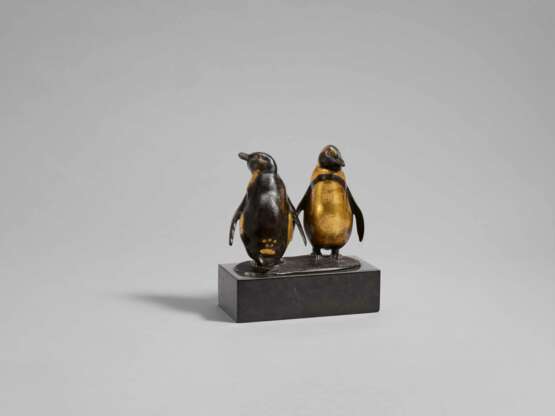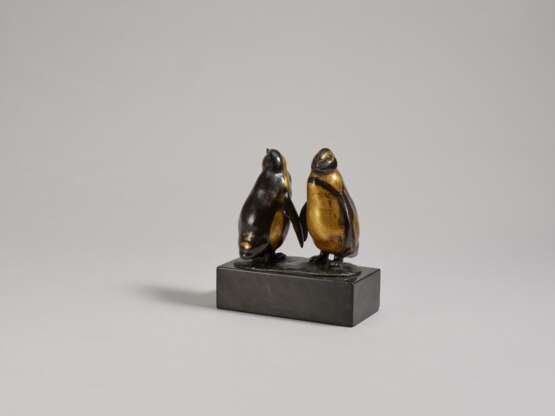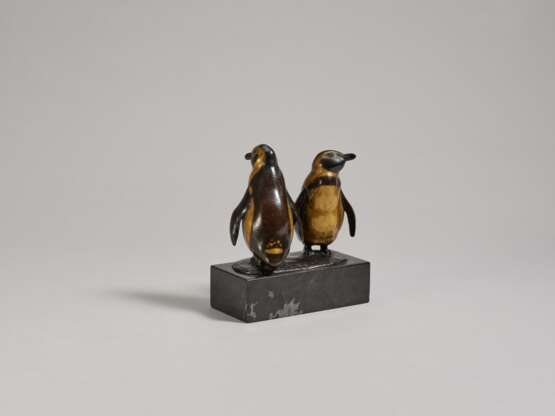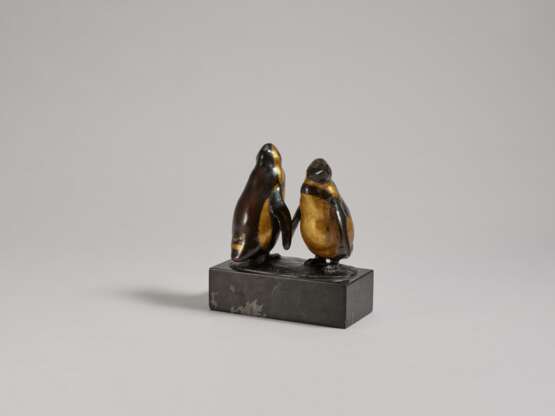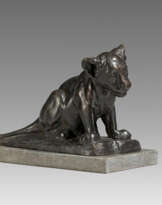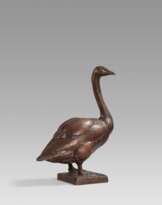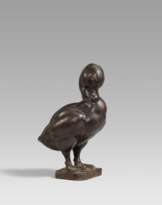ID 1208177
Лот 1194 | August Gaul. Two Penguins
Оценочная стоимость
€ 4 000 – 6 000
1869 Großauheim - 1921 Berlin
Title: Two Penguins.
Date: Ca. 1911.
Technique: Bronze, dark-brown-patinated and partially gilt.
Measurement: 15,5 x 17 x 9,5cm.
Notation: Inscribed on the plinth: "A. Gaul".
Plinth.
Literature:
J. Gabler: August Gaul. Das Werkverzeichnis der Skulpturen, Berlin 2007, p. 149,
No. 155-1.
Provenance:
Collection of the Berlin archaeologist Theodor Wiegand (1864-1936);
Since then in family possession.
"I don't want to pedantically imitate nature at all, but rather capture what is typical and its emotional core.... I make animals because it makes me happy."
These words come from August Gaul, one of the most influential sculptors of the turn of the century and a pioneer of modern sculpture in the 20th century.
The artist devoted himself almost exclusively to the depiction of animals, removing them from a larger context of meaning and making them worthy of depiction as autonomous living beings. Wild and domestic animals, which he produced in stone, bronze or porcelain, no longer symbolised human characteristics for him, but became the centre of attention for their own sake.
In the 19th century, interest in zoology grew steadily among the educated middle classes. Zoological gardens were founded in the larger cities, which were initially primarily intended to serve scientific research, but over time also served the bourgeois public for viewing and recreation. Alfred Edmund Brehm wrote his immensely successful and high-circulation "Tierleben" (Animal Life), which was extensively and impressively illustrated in its second edition in the 1870s.
It was against this background that August Gaul, the son of a stonemason from the provincial town of Großauheim near Hanau, set off for the metropolis of Berlin in 1888. He had gained experience in his father's workshop as well as during his training as a modeller and chaser in a silver processing company and at the Hanau Drawing Academy. In Berlin, Gaul initially worked in the arts and crafts and as a sculptor's assistant, in line with his training. Around 1892, he began studying at the art academy, where he became a pupil of the animal painter Paul Meyerheim.
Gaul's artistic interest had already focussed on animals since he had won a free annual ticket to the Berlin Zoo in a prize draw in 1890; here he found models in abundance.
As early as 1895, August Gaul became a master student of Berlin's leading sculptor Reinhold Begas. A competition organised by the academy, which Gaul won, was rewarded with a scholarship for a one-year stay in Rome in 1897/98. His impressions there, and in particular his contact with the somewhat older Begas student Louis Tuaillon, had a lasting influence on August Gaul's work. He moved away from the neo-baroque style of his teachers in favour of a simple, closed form.
After his return to Berlin, August Gaul, like Louis Tuaillon, was a founding member of the Berlin Secession in 1898, which propagated a rejection of the academic conception of art. In this circle around Max Liebermann and Walter Leistikow, he worked closely with Paul Cassirer. The well-connected gallery owner and secretary of the Secession became a close friend of August Gaul. Cassirer offered the artist a regular income and the advance financing of the expensive materials and casting costs, in return for which the gallery was granted the exclusive right to represent the artist. This extremely fruitful collaboration gave August Gaul access to new private collector circles and important museum contacts. In 1906, Alfred Lichtwark bought nine of Gaul's animal sculptures for the Hamburger Kunsthalle.
In 1908, August Gaul became a professor at the Berlin Academy of Arts and influenced younger sculptors with his style. Gerhard Marcks and Georg Kolbe also sought his advice. With his progressive view of art, he supported Ernst Barlach and the "animal specialist" was able to impress the acquisition commission of the Berlin National Gallery with his positive judgement of Franz Marc.
Some of the animal species that lived near water offered August Gaul the opportunity to use them either independently or in connection with a fountain. The penguins (lot 1194), the beavers (lot 1195) and the swans (lots 1198 and 1199) from the "menagerie" assembled in this catalogue can be seen in such a context. August Gaul's fountains were very successful with both private collectors and public clients. Examples of his practice of harmoniously merging autonomous animal sculpture with applied art in public spaces include the Duck and Swan Fountain in Berlin and the Penguin Fountain in Hamburg.
Gaul's training and skills as an artisan also shine through in the use of partial gold plating on his bronze sculptures. The penguins' plumage and the beavers' teeth emphasised in this way share the fact that Gaul was no purist. His bronzes could be enriched with a little "jewellery".
August Gaul was brilliantly able to harmonise the materials he worked with the animals he depicted. In some cases, it is possible to observe a summarised, yet clearly legible surface treatment that conveys the texture of beaver fur or swan feathers to the viewer. Other sculptures are less tactile. The striding deer (lot 1197) embodies more "the idea of a deer", which can be experienced through the silhouette. This may also be due to the fact that this sculpture emerged from the planning for a monument.
The hamster (lot 1196)- a small wartime antipode to the Berlin bear - is proof of August Gaul's sense of humour. The sculpture, made of iron in 1917, also occupies a special position in Gaul's oeuvre in terms of content. The little rodent personifies the perseverance of the population, who had to overcome the hardships of war by buying hamsters.
August Gaul's joy in the artistic depiction of his models is always palpable and is still conveyed to his audience today.
| Автор: | Август Гауль (1869 - 1921) |
|---|---|
| Категория аукционного дома: | Фигурные бронзы |
| Автор: | Август Гауль (1869 - 1921) |
|---|---|
| Категория аукционного дома: | Фигурные бронзы |
| Адрес торгов |
VAN HAM Kunstauktionen GmbH Hitzelerstr. 2 50968 Köln Германия | ||||||||||||||
|---|---|---|---|---|---|---|---|---|---|---|---|---|---|---|---|
| Предосмотр | |||||||||||||||
| Телефон | +49 221 92586215 | ||||||||||||||
| Факс | +49 221 92 58 62 4 | ||||||||||||||
| Комиссия | 32% | ||||||||||||||
| Условия использования | Условия использования | ||||||||||||||
| Часы работы | Часы работы
|
